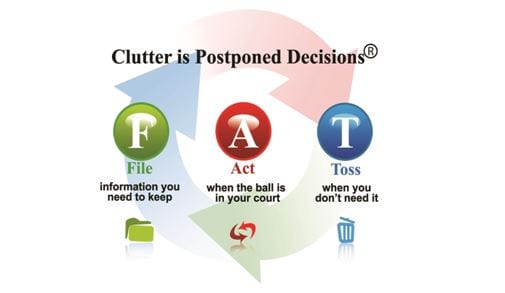Filing your paperwork is almost as exciting as watching paint dry. Unfortunately finding a place for your paperwork is necessary if you want to find it when you need it. I, like most of my clients (as well as most of the general population), do not like to spend time filing papers. As a result kitchen counters, desk tops, and home offices are often covered in papers that either need to be dealt with, filed for future reference, or recycled/shredded. Clearing the paper clutter does not have to consist of endless amounts of time filing, you do have options:
Store Less, Find More – 80% of what most people file is never looked at again. Therefore, file drawers are oftentimes overstuffed with unnecessary information. Use the Art of Wastebaketry™ to help you determine what is really worth taking the time to file and what you can safely recycle or shred. The less you have to file means you’ll save filing time and are more likely to file things in a proper place. In addition, the less you store the more likely you are to find it when you need it.
Know Your Buckets – Whether you prefer to file or pile, you need to create identifiable spots for the information you want to keep. Think about the kinds of paperwork you’re often looking to refer to or save, and those become your “buckets” of information. For example, most people need a place to store the following:
- Taxes by Year
- Donation Receipts
- Home Repair
- Home Improvement
- Medical
- Auto
- Insurance (home/life/auto)
- Kids School and Activities
Other common types of information (bank statements, monthly bills, etc.) do not need to be saved and can be recycled or shredded.
Filer – If you prefer files over piles like me, then take the time to create a good file system. Once you’ve determined your “buckets“, create appropriately named files using folders with clearly written or typed labels. For easy retrieval, arrange your file folders in alphabetical order within the file drawer. Ensure your file drawers do not contain too much stuff so that they are easy to access and allow you to easily find what you need.
Piler – If you really want to get rid of the paper clutter, but don’t want to take the time to file, there is an alternative solution. Once you’ve identified your “buckets“, create labeled containers with the appropriately named titles. Store the containers on an easily accessible shelf and just toss your papers inside.
- Literature Sorter – When you have a variety of “buckets” of information, a literature sorter offers you plenty of piling space. Label the edge of each section and file your papers accordingly.
- Magazine Holder – Magazine holders keep your papers vertical, thus giving you an option for piling even when you are limited by space. They come in a wide variety of colors and styles and allow you to easily drop your papers inside.
- Bins/Baskets – A quick and dirty solution for the true piler. Just place the container of your choice on a shelf and pile away. You can use traditional paper trays, serving trays from your kitchen, open baskets, plastic bins, or whatever you prefer that is large enough to hold various 8.5X11 sheets of paper. Ensure you maintain your “bucket” system by labeling each bin/basket appropriately.
Whether you choose to file or pile, stop rustling through random piles of papers trying to find what you need. Follow these helpful tips to finally clear the paper clutter once and for all!


